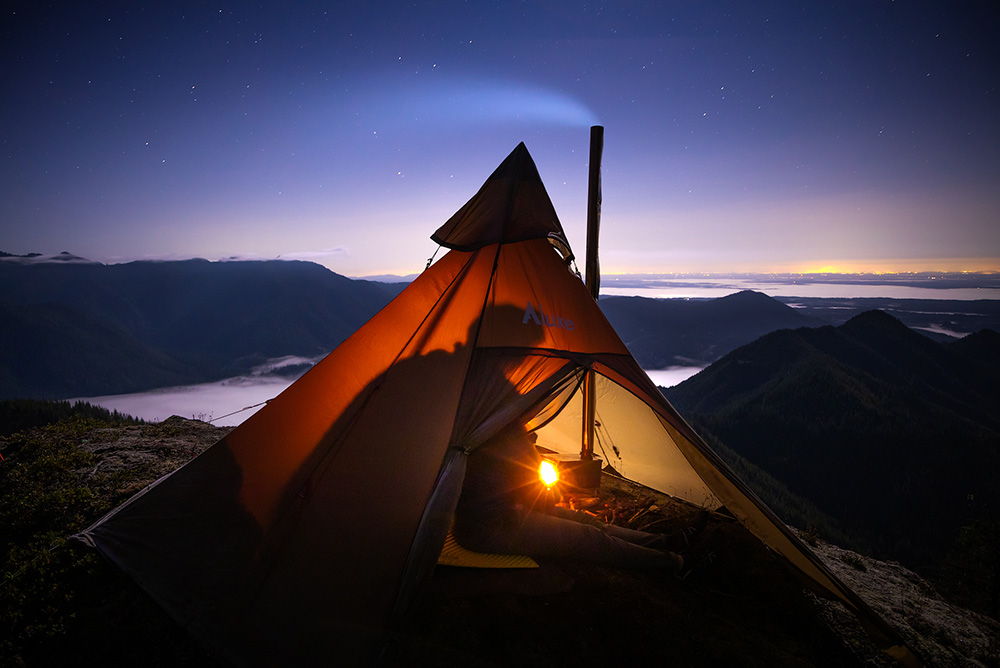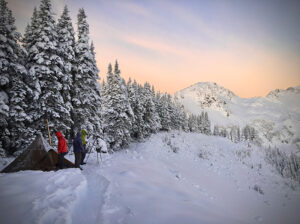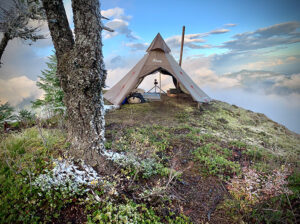Hot tent backpacking might sound intense, but once you try it, it’s hard to go back. Imagine this: you’re deep in the backcountry, snow falling outside, and you’re warm, dry, and sipping something hot inside your tent—thanks to a tiny wood stove crackling away beside you.
This guide is here to help you get started. I’ll walk you through the basics: what a hot tent setup actually is, the gear you’ll need, how to stay safe, and what to expect your first time out. Whether you’re new to winter camping or just looking to stay more comfortable on cold trips, this is everything I’ve learned from hands-on experience.
Let’s get into it.

Page Contents
What is Hot Tent Backpacking?
Hot tent backpacking is exactly what it sounds like: camping with a tent that’s heated from the inside using a portable wood stove. Unlike traditional backpacking tents, a hot tent is made from fire-safe materials and includes a stove jack (an opening where the stove pipe goes out), letting you safely burn wood and warm up your space.
It’s popular with winter campers, hunters, and anyone who doesn’t like freezing their toes off while trying to sleep in a snowstorm. The biggest draw? You can dry out wet clothes, cook inside when weather turns, and actually relax in comfort—no matter how cold it gets outside.
Some setups are ultralight and made for solo hikers, while others are more spacious for group trips. Either way, it opens the door to year-round adventures, even when the trails are covered in snow.

Essential Gear for Hot Tent Backpacking
You don’t need a huge pack or a mountain of gear to enjoy hot tent backpacking—you just need the right setup. Here’s what I recommend based on real use out in the cold:
1. Hot Tent
Choose a tent that’s made from fire-resistant materials and has a stove jack built in. Look for one that balances weight with durability. For backpacking, pyramid-style or teepee-style tents are popular since they’re lightweight, simple to pitch, and shed snow well.
Tip: Make sure your tent has good ventilation options to manage condensation and airflow, especially with a stove burning inside.
2. Wood Stove
A lightweight, packable stove is the core of your hot tent setup. Most backpackers go with titanium or stainless steel stoves that fold flat and assemble easily in the field. It should be sized appropriately for your tent and have a chimney that fits the jack opening.
Bonus: Most stoves allow you to cook right on the top, which means fewer items in your pack.
3. Spark Arrestor and Ground Protection
Always use a spark arrestor to prevent stray embers from flying out of your chimney and burning holes in your tent. It’s also smart to carry a small heat-resistant mat to place under the stove—this helps protect your tent floor and adds a layer of safety.
4. Cold-Weather Sleep System
Even with a stove, the fire will go out while you sleep—so your sleep system still matters. Bring a well-rated sleeping bag (aim lower than the expected temps) and a solid sleeping pad with good R-value insulation.
Tip: A closed-cell foam pad under your inflatable one adds warmth and protects against punctures.
5. Fire Tools and Fuel
You’ll need a way to gather and process firewood. A small backpacking saw and hatchet works well. Also bring a fire starter you trust—ferro rod, waterproof matches, or a lighter. If there’s snow, consider packing a small mat or kneeling pad for tending the fire without freezing your knees. I always have a z-seat on my trips.

Safety Tips for Staying Warm and Protected
Staying warm in the backcountry is great—but safety comes first, especially when you’re using a wood stove inside a tent. With a few smart habits, hot tenting can be both comfortable and safe.
1. Ventilation Is Everything
A sealed-up tent might feel cozy at first, but it can become dangerous fast. Always keep a vent open—at the top and bottom if possible—to let in fresh air and prevent carbon monoxide buildup. Even in freezing temps, airflow is non-negotiable.
2. Use a Spark Arrestor
A spark arrestor is a small mesh screen that fits on the end of your stove pipe. It catches hot embers before they escape and melt holes in your tent—or worse. Don’t skip it, even if your stove seems safe.
3. Never Leave the Stove Unattended
It’s tempting to load the stove up and go to sleep, but leaving a fire burning overnight is a risk not worth taking. Burn it while you’re awake, then let it die down before bed. That’s where your sleeping bag comes in.
4. Clear the Area Around the Stove
Make sure nothing flammable is within a foot or two of your stove. That includes gear, sleeping bags, and especially synthetic fabrics. A small fireproof mat underneath is a good idea, and so is double-checking your setup before lighting up.
5. Practice Before You Go
If this is your first time with a hot tent setup, test it at home or in a safe spot close to your car. Learn how the stove draws air, how fast it burns fuel, and how it handles wind and cold. The backcountry isn’t the place for surprises.

Recommended Hot Tents and Stoves
There are a lot of options out there, and choosing the right hot tent setup really comes down to your pack weight, how many people you’re camping with, and the kind of conditions you’re heading into. Below are a few solid picks that I’ve either used personally or seen out in the wild that hold up well when things get cold.
Hot Tents
1. OneTigris Smokey Hut
Lightweight, budget-friendly, and easy to set up. This is a good entry-level pyramid tent with a stove jack already installed. Works well for solo or tight two-person trips. Just be aware that it doesn’t come with a floor or inner mesh.
Great for: solo backpackers who want to test out hot tenting without breaking the bank.
2. Seek Outside Cimarron
A step up in quality and price, but well worth it if you’re going on longer or more rugged trips. This is a true ultralight shelter built for serious backcountry use. Tons of space for the weight, great in snow, and the materials are top-notch. Solid option if your sharing it with somebody else.
Great for: lightweight winter backpackers who want space and durability.
3. Pomoly Hot Tents
Pomoly has been putting out some of the best hot tent options that strike a balance between durability and comfort. They are my current go to. The build quality is exceptional and typically better priced than Seek Outside. With many different options to choose from, I encourage you to deep dive and see which one is the best fit for you.
Wood Stoves
1. Winnerwell Fastfold Titanium Stove
Weighs just a few pounds and folds down flat, making it perfect for backpacking. Burns hot and clean, and the titanium construction means it holds up to repeated use. Setup can be a little fiddly at first, but gets easier over time.
Great for: backpackers who want a reliable stove without adding bulk.
2. Pomoly Titanium Stove – Glass Doors
My personal choice. The size is ideal for cooking and the glass windows make for a memorable experience. Works great in small to mid-size hot tents. Have put mine to the test with 50+ days of use so far.
Great for: cooking and enjoying the fire, also lightweight and one of the best price points for a titanium stove.
3. Seek Outside SXL Titanium Stove
Premium option, lightweight and efficient. If you’re investing in a long-term setup, this is the kind of stove that will go the distance. Packs down small and pairs perfectly with their tents. Option for a glass door.
Great for: serious winter backpackers and multi-night trips in colder climates.
Frequently Asked Questions
Is hot tent backpacking safe?
Yes, as long as you follow basic safety rules: keep your tent ventilated, never leave your stove burning unattended, and make sure your gear is set up correctly. Like anything outdoors, a little caution goes a long way.
Can you sleep with the stove on?
Technically you can—but it’s not recommended. Most hot tent campers burn the stove while they’re awake, then let it die down before sleeping. That’s why a good sleeping bag and pad are still essential.
Do I need a special tent for hot tenting?
Yes. You’ll need a tent with a stove jack—either built in or added later—and made from materials that can handle the heat. Regular backpacking tents won’t work safely with a stove.
How heavy is a hot tent setup?
It depends on the gear. Ultralight setups can come in under 10 pounds total (tent + stove), but some canvas or group-sized setups weigh much more. If you’re backpacking, look for titanium stoves and single-wall tents designed for solo use.
Can I use a hot tent in warmer weather?
You can, but you probably won’t want to carry the stove. Many hot tents can double as regular shelters when the stove isn’t needed, especially if you have a removable jack cover.
Hot Tent Backpacking Checklist for Beginners
Here’s a quick checklist to help you pack smart and stay warm out there:
Shelter
-
Fire-resistant hot tent with stove jack
-
Groundsheet or floor (I prefer just a groundsheet)
-
Tent stakes and guy lines
Stove Setup
-
Lightweight wood stove (foldable preferred)
-
Spark arrestor
-
Chimney pipe and support rings
-
Heat-resistant mat or baseplate
Sleep System
-
Cold-rated sleeping bag
-
Insulated sleeping pad (R-value 4+ recommended)
-
Pillow or stuff sack with clothes
Clothing
-
Thermal base layers
-
Insulating mid-layer (fleece or down)
-
Waterproof outer shell
-
Extra dry socks and gloves
Fire & Tools
-
Folding saw or small axe
-
Fire starter (ferro rod, lighter, or matches)
-
Small brush or bandana for cleaning ash
-
Wood or plan to gather fuel
Extras
-
Heat rated gloves
-
Cooking pot (titanium to keep things light)
-
Headlamp
Final Thoughts
Hot tent backpacking isn’t just about staying warm—it’s about opening up the trail year-round. With the right setup, you can turn a frozen night in the woods into a cozy, memorable trip. It takes some planning and practice, but once you get the hang of it, you’ll wonder why you didn’t start sooner.
If you’re just getting into it, keep it simple. Test your gear, go out on short trips, and build confidence over time. And remember—whether it’s your first winter overnight or your tenth, being prepared is what makes it fun.
Want more tips like this? Check out my Backpacking Gear Guide or join my newsletter for trail-tested advice, gear lists, and fresh posts.
Happy trails,
Iron
Leave a Reply